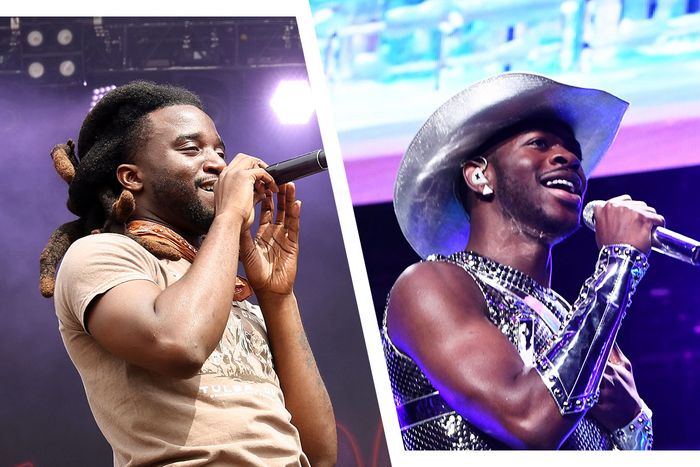
At the beginning of his career, Shaboozey’s interests in country and rap felt like dueling contradictions. He got signed to Republic Records as a rapper, on the heels of his brash trap song “Jeff Gordon,” but he loved the country music he grew up with too, like the Kenny Rogers songs his dad listened to. When it was time to release a debut album, Shaboozey put off a planned country full-length in favor of Lady Wrangler, a more mainstream project with only fleeting moments of southern style. “I felt like the world, or the culture, or even I wasn’t ready for it yet,” he said of his shelved record.
When Lady Wrangler underperformed, Republic dropped Shaboozey. Only with the confident backing of new managers did he finally begin pursuing the sound he wanted. Now, Shaboozey has all of America singing along. His runaway hit “A Bar Song (Tipsy)” just logged its 19th week atop the Hot 100, tying the record for the most weeks at No. 1 on the all-genre chart. In doing so, Shaboozey matched the feat of another runaway country-rap hit, Lil Nas X’s “Old Town Road,” which peaked in 2019.
For years, the two genres were such polar opposites that the idea of fusing them seemed like a joke and often backfired. Now, Shaboozey is once again proving how successful it can be. But what makes that fusion such a winning combination? It’s in the very novelty of bringing those genres together. At any given point this year, there were over a half-dozen young female pop stars or emotional male singer-songwriters competing for our attention — and thus frequently replacing each other at the top of the charts. But when it came to country-rap, Shaboozey had a lane to himself. For multiple weeks, “A Bar Song (Tipsy)” was No. 1 in sales, streaming, and radio, the three factors that decide Hot 100 rankings. Like “Old Town Road” — which never topped the radio charts but did spend 16 weeks at No. 1 for sales and 20 weeks for streaming — fans couldn’t get enough of it.
At one point, a hit had to be an event to have those kind of legs. Take “One Sweet Day,” the collaboration between Mariah Carey and Boyz II Men that became the Hot 100’s first 16-week leader. Separately, Carey and Boyz II Men were already two of the biggest things on the charts, so a collaboration between them setting a new record was just a matter of simple math. Their record stood for decades, until an unlikely song matched it: “Despacito,” a linkup between Puerto Rican singer Luis Fonsi, reggaeton king Daddy Yankee, and pop prince Justin Bieber. This wasn’t an event in Carey–and–Boyz II Men terms — Yankee, while a star in Latin music, had never had a top-ten all-genre single in the U.S., and Fonsi had never charted past No. 90. This was something new for pop — an already established star like Bieber jumping on the remix made “Despacito” just familiar enough for listeners to give it a chance.
Like Bieber hopping on “Despacito,” Lil Nas X got “Old Town Road” across the finish line with an assist from a Billy Ray Cyrus remix. Obviously, Cyrus didn’t have nearly the same clout as Bieber. Instead, it was that country-rap blend that convinced listeners to ride with a new artist like Lil Nas. Pop listeners tend to have (often misguided) opinions about those two genres: Rap is crass, country is uncool. But each can make the other more approachable. Rap influence can make a country song seem more stylish to non-listeners, while country influence can soften a rap song. Bringing in rap or country fans can help, but the goal is broad, four-quadrant pop appeal. That’s how “Old Town Road” succeeded in spite of Billboard removing it from the country charts: It captured the attention of a bigger audience. Shaboozey was only able to vindicate Lil Nas with a No. 1 at country airplay once he’d already become too big of a pop hit for the genre to ignore.
Shaboozey’s hit could be a “fool me twice, shame on me” moment for the pop industry, which didn’t seem to start taking country music’s commercial prospects seriously after “Old Town Road.” But if major labels start launching dozens of country-rap songs onto the charts over the next few years, the very novelty that helped “Old Town Road” and “A Bar Song (Tipsy)” become hits will be lost. Country-rap still deserves a bigger moment in the spotlight, for other artists coming up and as Shaboozey continues trailblazing in his own career. But the bigger lesson should be that any artist who doesn’t fit neatly into prescribed genre boxes could already be working on the next big hit. Republic kicked Shaboozey out the door. Will it make that mistake again?


